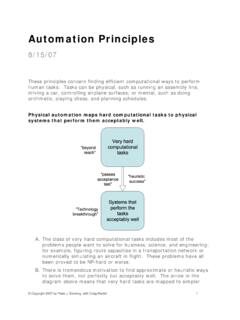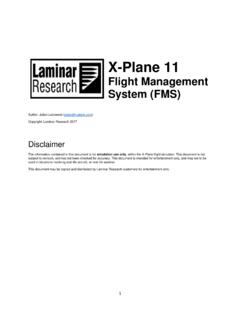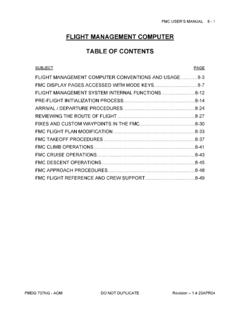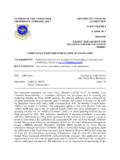Transcription of COMPUTER SCIENCE: THE DISCIPLINE - DENNING INSTITUTE
1 COMPUTER SCIENCE: THE DISCIPLINE . Peter J. DENNING August 1997. Revised July 1999. Copyright 1999 by Peter J. DENNING . You may make one exact copy for personal use. Any other copying or distribution requires explicit permission. This article will appear in the 2000 Edition of Encyclopedia of COMPUTER Science (A. Ralston and D. Hemmendinger, Eds). The computing profession is the people and institutions that have been created to take care of other people's concerns in information processing and coordination through worldwide communication systems. The profession contains various specialties such as COMPUTER science, COMPUTER engineering, software engineering, information systems, domain-specific applications, and COMPUTER systems. The DISCIPLINE of COMPUTER science is the body of knowledge and practices used by computing professionals in their work.
2 This article, with many cross-references to other articles in this encyclopedia, discusses these aspects of the profession and the relations among them. The DISCIPLINE of COMPUTER science was born in the early 1940s with the confluence of algorithm theory, mathematical logic, and the invention of the stored-program electronic COMPUTER . Examples are the works of Alan Turing and Kurt Godel in the 1930s about algorithms and their realizations as machines or rule-systems, the algorithms created by Ada Lovelace sixty years earlier, the analog computers built by Vannevar Bush in the 1920s, and the electronic computers built by Howard Aiken and Konrad Zuse in the 1930s. The writings of John von Neumann demonstrate considerable intellectual depth to the emerging DISCIPLINE by the late 1940s.
3 By the early 1960s, there was a sufficient body of knowledge to merit the first academic departments and degree programs. This DISCIPLINE is also called COMPUTER science and engineering, computing, and informatics. The body of knowledge of computing is frequently described as the systematic study of algorithmic processes that describe and transform information: their theory, analysis, design, efficiency, implementation, and application. The fundamental question underlying all of computing is, What can be (efficiently) automated? This common characterization is too austere. It only hints at the full richness of the DISCIPLINE . It does not call attention to the connections between computing knowledge and the concerns of people to whom this knowledge contributes, notably the universal concerns for reliability, dependability, robustness, integrity, security, and modifiability of COMPUTER systems.
4 It hides the social and historical context of the field and the values of the people who practice in it. The following discussion of the DISCIPLINE calls attention to these important larger questions. The Domain of COMPUTER Science Even though COMPUTER science addresses both human-made and natural information processes, the main effort in the DISCIPLINE has been directed toward human-made processes, especially information processing systems and machines. Much of the work of the field until the mid 1980s concerned computers as number-crunchers, symbol-manipulators, and data processors;. but the personal COMPUTER and the Internet have since enlarged the focus to include coordination and communication. Much of the body of knowledge of computing concerns the digital COMPUTER and the phenomena surrounding it --- the structure and operation of COMPUTER systems, principles underlying COMPUTER system design and programming, effective methods for using computers for information processing tasks, and theoretical characterizations of their properties and limitations.
5 The field is grappling with new questions arising from interactions with other fields, where computers are tools but not the objects of study, and where other considerations such as transparency, usability, dependability, reliability, and safety are paramount. Computing is also contributing to other fields by showing them how to model their processes as information processes. Several have been prominent. Biologists now view DNA as an encoding of information needed to generate a unique organism; they seek algorithms that can construct complete genome sequences from fragments scattered across many databases. Psychologists and cognitive scientists, who have collaborated for many years with COMPUTER scientists on models of cognition, have been joined by neuroscientists who seek to model neural systems and use the models to explain cognitive behavior of organisms.
6 Physicists have discovered new materials that have been used for ever-smaller chips and ever-faster communication media. Other disciplines are beginning to contribute ideas for the construction of new machines, such as silicon chips that simulate body parts like eyes and ears, biological memories, DNA chemical solutions that compute combinatorial problems, or quantum processes for superparallel computation and cryptography. -2- Standard Concerns of the Field The digital COMPUTER plays the central role in the field because it is a universal computing machine: with enough memory, a digital COMPUTER is capable of simulating any information processing system, provided the task can be specified as an unambiguous set of instructions. If such a specification is possible, the task can be represented as a program that can be stored in the memory of a COMPUTER .
7 Thus, one machine is capable of exploring and studying an enormous variety of concepts, schemes, simulations, and techniques of information processing. Every practitioner of the DISCIPLINE must be skilled in four basic areas: algorithmic thinking, representation, programming, and design. Algorithmic thinking is an interpretation of the world in which a person understands and formulates actions in terms of step-by-step procedures that give unambiguous results when carried out by anyone (or by a suitable machine). It resembles standard scientific thinking, which seeks to invent standard ways of observing that allow anyone to see and reproduce physical effects. Algorithmic thinking emphasizes the standard procedure and scientific thinking the standard observer.
8 Representation addresses the way in which data are stored so that the questions one will ask about them can be answered efficiently. For example, the standard phone book is organized for quick answer of the question, What is the phone number assigned to person N? When stored in a COMPUTER database, the machine goes quickly to the alphabetic part of the list containing the name N. This is not an efficient organization for the question, To whom is the phone number N assigned? because the standard book would have to be searched entry by entry until the given phone number is found. A data organization more suited to the second question is the inverted phone book, in which the phone numbers are listed in their numeric order, accompanied by the names of their owners.
9 The skill of representation goes beyond knowing how to organize data for efficient retrieval or processing. It deals with inventing ways of encoding phenomena to allow algorithmic processing. Examples include representing a mathematical expression so that it can be differentiated, representing a document so that What you see [on the screen] is what you get [on the printer] ; representing handwritten zip codes for automatic recognition and sorting by the Postal Service; representing encoded speech so that one can talk to a COMPUTER or so that the COMPUTER can talk; representing an engine part so that it can be shown on the graphics screen and can also be manufactured automatically. Programming enables people to take algorithmic thinking and representations and embody them in software that will cause a machine to -3- perform in a prescribed way.
10 This skill includes working knowledge of different programming languages (each having its own strengths and limitations), program development tools (which aid testing, debugging, modularity, and compatibility), and operating systems (which control the internal operations of computers). Design connects the other three skills to the concerns of people, though the medium of systems that serve them. Design includes many practical considerations such as engineering tradeoffs, integrating available components, meeting time and cost constraints, and meeting safety and reliability requirements. Even though everyone in the DISCIPLINE is expected to know these skills, it is a mistake to equate COMPUTER science with any one of them, , programming.






